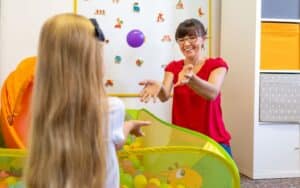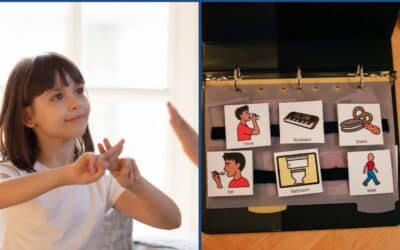Participating in speech-language therapy (SLT) can be highly impactful for children experiencing speech, language, and communication difficulties as well as for their families. This article discusses what to expect during your child’s speech-language therapy session. It will describe the multidimensional approach of SLT, explaining how it correlates with developmental ages of the participants and how it is tailored to individual needs and interests and based on the results from their speech-language evaluation. We will also discuss the vital role parents play in the speech-language therapy process and provide useful resources.
Speech-Language Therapy Session Approaches
Speech-Language Pathologists (SLPs) carefully design speech-language therapy sessions based on goals derived from each child’s evaluation. These goals are tailored to match their identified speech and language strengths and areas of need, developmental age, and interests. This ensures the therapy is engaging, focused, enjoyable, and fruitful. For example, sessions for a child intrigued by cars needing articulation practice might include car-centric articulation activities. It may look like just play, but play is being used to achieve goals. When you know what to expect during your child’s speech-language therapy session, it helps you to be more engaged and supportive in their learning process, enhancing the effectiveness of the therapy.

Varied Focus Areas in Speech-Language Therapy Sessions
- Speech Sound Production/Articulation: This targets the pronunciation of sounds. It usually involves modeling, listening, imitation, shaping, and practice activities of specific speech sounds and/or groups of speech sound.
- Receptive Language: This targets understanding of language. It may involve activities to support an understanding of words and their meaning, following instructions, responding to questions, and engaging in conversation. This can include spoken as well as written language.
- Expressive Language: This enhances language use. It may include activities like naming and describing objects, actions, and concepts, formulating grammatically correct sentences, explanation, and storytelling.
- Pragmatic Language: This addresses improving social communication skills such as eye contact, reading and exhibiting non-verbal cues, and turn taking. Strategies could possibly include modeling, role plays, or conversation scenarios.
- Fluency: This focuses on the flow or smoothness of speech. Sessions may involve techniques like awareness, relaxation, pacing, rhythm, modeling and imitation, and self-critique and feedback.
- Voice: This focuses on voice quality and use, such as involving activities related to vocal hygiene, breathing, and pitch modulation.
- Oral Motor Skills: This area addresses improving awareness, strength, and movement of the structures involved in articulation. Activities may include using a mirror to support mouth movements, blowing bubbles to practice lip rounding, or imitating various tongue and lip movement patterns.
Speech-Language Therapy Sessions and Child’s Chronological and Developmental Age
While the scope and process of speech-language therapy is individualized for each child, the style of therapy is often guided by a child’s developmental age. Let’s talk about what speech-language therapy sessions at different developmental levels (not focusing on voice or fluency in this article) may look like.

Early Intervention (Ages 0-3)
During these foundational years, therapies are play-based, emphasizing developmental milestones like the emergence of first words. Early Intervention sessions employ adult modeling and multi-sensory exploration and use of toys, objects, music, art materials, books, and games to foster engagement, motivation to communicate, understanding and use of language, and speech sound production. Parent and caregiver involvement is critical to extend learning beyond the time limits of the sessions.

Preschool Age (3-5 years)
In this phase, therapy may become more structured, focusing on specific speech sounds, vocabulary, understanding and use of more complex language features, sentence formation, and grammar skills. Activities like picture cards, stories, crafts, and technology may be added, keeping the child’s interests, developmental needs, and goals in mind.
School Age (6-12 years)
Sessions at this stage may be more task-oriented, addressing specific speech sound production, reasoning, explanation, conversation, and social language skills. These mirror the developmental transition in forming complex sentences and comprehending nuanced instructions.
Adolescents (13-18 years)
For teenagers, sessions may focus on more abstract thinking, problem-solving, use of language in various academic and social settings, and advanced language understanding and usage. Therapy meets the needs of the individual as they move towards young adulthood, refining their communicative abilities.
Young Adults (19-25 years)
In this stage, therapy becomes more specialized, emphasizing the refinement of communication skills vital for social interactions, academia and the workplace, respecting the individual’s developmental maturity.
The Significant Role of Parents in Speech Language Therapy
The participation of parents in SLT is not merely beneficial; it’s integral to the success of the therapy. Parents are not just observers; they are active contributors in shaping the therapy’s outcomes and extending learning and practice into daily routines.
Emotional Comfort and Support
Parents provide a sense of familiarity and security, making children more receptive to therapy. Their presence can significantly reduce anxiety and enhance the child’s willingness and motivation to participate.
Consistent Reinforcement
Parents can extend the learning from the therapy sessions to home, providing consistency and reinforcement. Regular practice at home reinforces the learning and helps in faster internalization of the skills focused on during therapy.

Continuous Feedback and Collaboration
Parents’ insights and observations are invaluable. They can offer ongoing feedback about the child’s progress and challenges, allowing the SLP to adjust strategies as needed. Collaboration between parents and SLPs ensures that the therapy is more tailored and responsive to the child’s evolving needs, interests, and strengths.
Enhancement of Learning Opportunities
Parents can create enriched learning environments at home, presenting ample opportunities for the child to practice new skills in real-life situations. This amplifies the child’s exposure to language and provides diverse situations to apply newly acquired skills, thereby solidifying learning.
FAQs
1. How is a child’s progress in speech-language therapy assessed?
Observations, standardized tests, and informal assessments assess progress, and regular updates are provided to parents.
2. What role do parents have in speech-language therapy?
Parents participate in sessions, learn techniques, and practice with their child at home, maintaining regular communication with the speech-language pathologist.
3. How long are speech-language therapy sessions and how frequent?
Typically, sessions are 30 to 60 minutes long and held once or twice a week, but this varies based on the child’s individual needs.
4. How does a speech-language pathologist adapt sessions for different child needs?
SLPs tailor sessions to each individual by focusing on their particular strengths, needs, and goals and using a variety of engaging learning materials, focused exercises, and enjoyable activities. They adjust the complexity of tasks, strategies, and tools to match the developmental stage and interests of the child.
Additional Resources
- Who Are Speech-Language Pathologists, and What Do They Do? (asha.org)
- Speech-Language Therapy (for Parents) – Nemours KidsHealth
- What is speech therapy? (understood.org)
Summary/Conclusion
Navigating through the multifaceted realm of speech-language therapy, understanding its relation to developmental ages, and the ways it is customized for individual needs, is essential for parents. This helps parents to know what to expect during their child’s speech therapy. The invaluable role of parents extends beyond mere attendance during therapy sessions; it involves active participation, continuous reinforcement, and collaborative feedback to contribute to the therapy process. The journey is distinctive and evolving; stay informed, be actively involved, and celebrate effort and progress together.





0 Comments